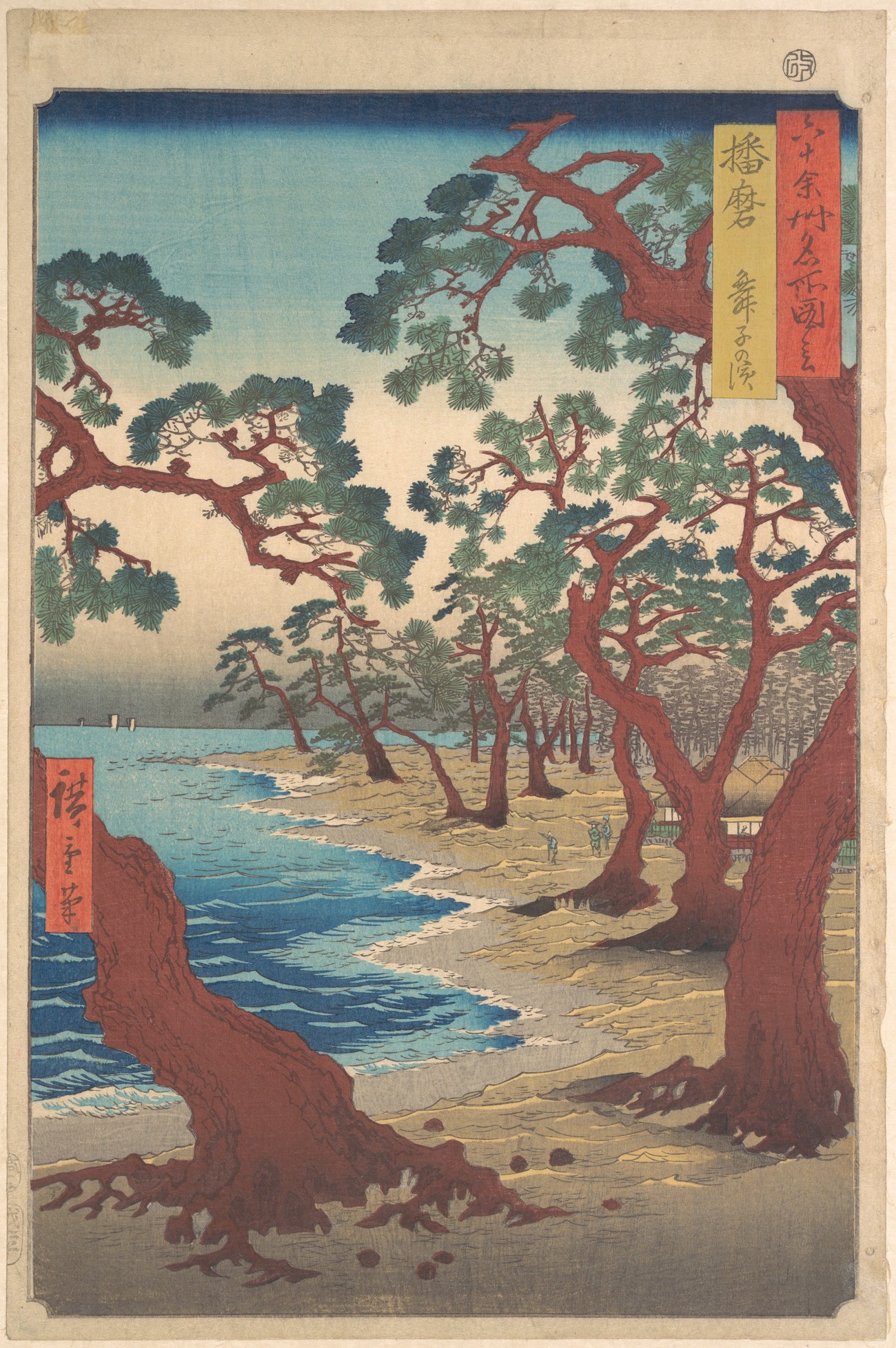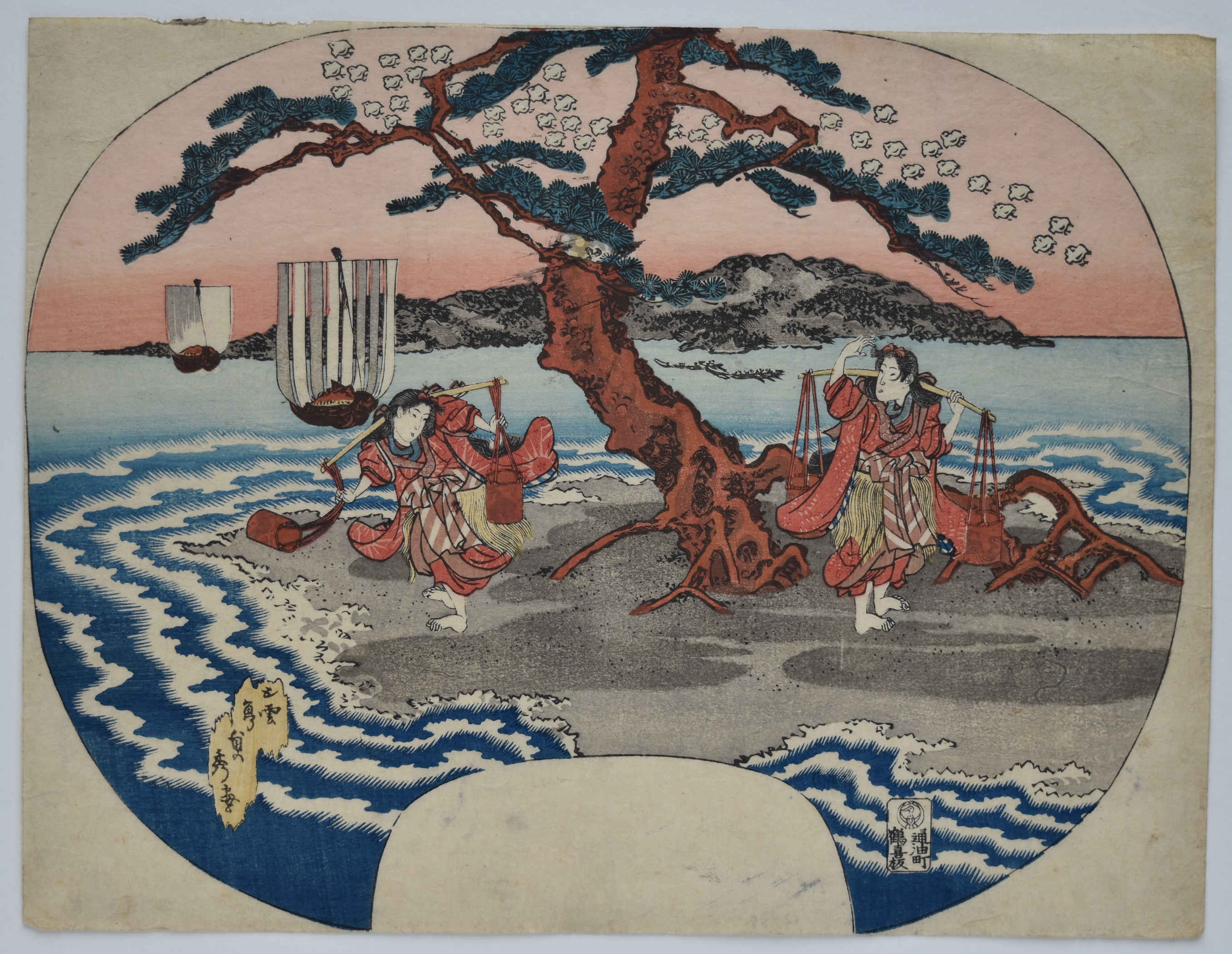 See also Maiko Beach, Harima Province, from the series Views of Famous Places in the Sixty-Odd Provinces,
See also Maiko Beach, Harima Province, from the series Views of Famous Places in the Sixty-Odd Provinces,
-
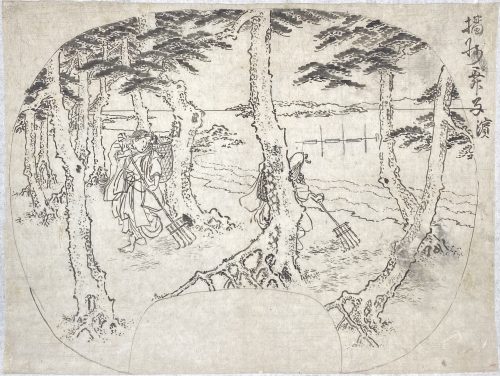 Artist: Veronica Miller attributes the drawing to Utagawa Sadahide [歌川 貞秀] (Japanese, 1807 – 1879), also known as Gountei Sadahide [五雲亭 貞秀]. A preparatory drawing for a fan print depicts two women raking pine needles along the scenic beach at Harima. Inscription at top right "Maiko Beach in Harima" (Harima Maiko no Hama) [播磨 舞子濱], which is now located in Hyōgo Prefecture. The view must be of the Akashi Strait, looking towards Awaji Island. Drawn on thin hanshita paper, mounted lightly at the top to a backing paper, but unbacked. Size: 240 x 319 mm. Attribution to Sadahide based on his design titled "Suma Bay: Matsukaze and Murasame" (see below):
Artist: Veronica Miller attributes the drawing to Utagawa Sadahide [歌川 貞秀] (Japanese, 1807 – 1879), also known as Gountei Sadahide [五雲亭 貞秀]. A preparatory drawing for a fan print depicts two women raking pine needles along the scenic beach at Harima. Inscription at top right "Maiko Beach in Harima" (Harima Maiko no Hama) [播磨 舞子濱], which is now located in Hyōgo Prefecture. The view must be of the Akashi Strait, looking towards Awaji Island. Drawn on thin hanshita paper, mounted lightly at the top to a backing paper, but unbacked. Size: 240 x 319 mm. Attribution to Sadahide based on his design titled "Suma Bay: Matsukaze and Murasame" (see below): See also Maiko Beach, Harima Province, from the series Views of Famous Places in the Sixty-Odd Provinces,
See also Maiko Beach, Harima Province, from the series Views of Famous Places in the Sixty-Odd Provinces,
-
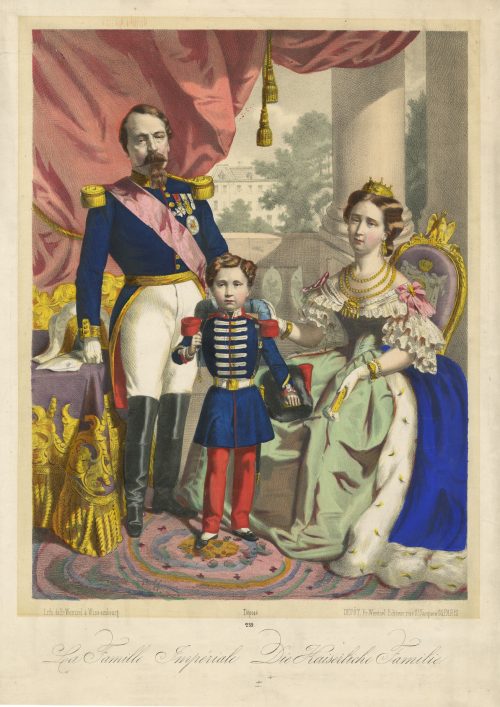 Hand-coloured lithography on wove paper, 395 x 280 mm; black ink stamp “5309” to reverse. On image: artist's initials "L. H."; on stone: "Lith. de Fr. Wentzel a Wissembourg. — Déposé — DÉPÔT, Fr. Wentzel Editeur rue St. Jacques 65, PARIS"; below centre: "239"; bottom : La famille Impériale. Die Kaizerliche Familie. Napoleon III [Charles-Louis Napoléon Bonaparte] (French, 1808 – 1873) Eugénie de Montijo [L'impératrice Eugénie] (Spanish-French, 1826 – 1920) Napoléon, Prince Imperial (Napoléon Eugène Louis Jean Joseph Bonaparte] (French, 1856 – 1879) Jean Frédéric Wentzel (French, 1807 – 1869) – publisher/printer.
Hand-coloured lithography on wove paper, 395 x 280 mm; black ink stamp “5309” to reverse. On image: artist's initials "L. H."; on stone: "Lith. de Fr. Wentzel a Wissembourg. — Déposé — DÉPÔT, Fr. Wentzel Editeur rue St. Jacques 65, PARIS"; below centre: "239"; bottom : La famille Impériale. Die Kaizerliche Familie. Napoleon III [Charles-Louis Napoléon Bonaparte] (French, 1808 – 1873) Eugénie de Montijo [L'impératrice Eugénie] (Spanish-French, 1826 – 1920) Napoléon, Prince Imperial (Napoléon Eugène Louis Jean Joseph Bonaparte] (French, 1856 – 1879) Jean Frédéric Wentzel (French, 1807 – 1869) – publisher/printer. -
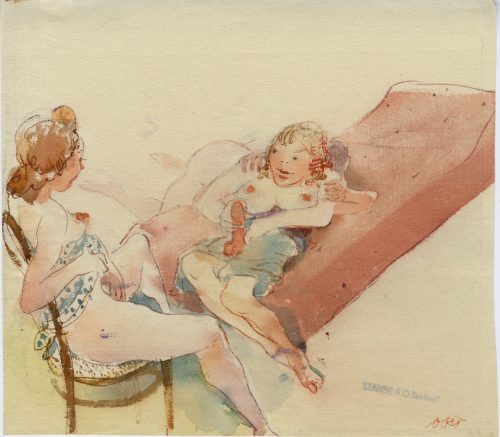 Watercolour on laid paper, 198 x 225 mm, signed or stamped in orange ink “ORS” to recto [Otto Rudolf Schatz (Austrian, 1900 – 1961)]; black ink stamp: “Nachlaß O R SCHATS”, pencil “ss” in the bottom left corner, and remnants of a hinge on the upper right to verso.
Watercolour on laid paper, 198 x 225 mm, signed or stamped in orange ink “ORS” to recto [Otto Rudolf Schatz (Austrian, 1900 – 1961)]; black ink stamp: “Nachlaß O R SCHATS”, pencil “ss” in the bottom left corner, and remnants of a hinge on the upper right to verso. -
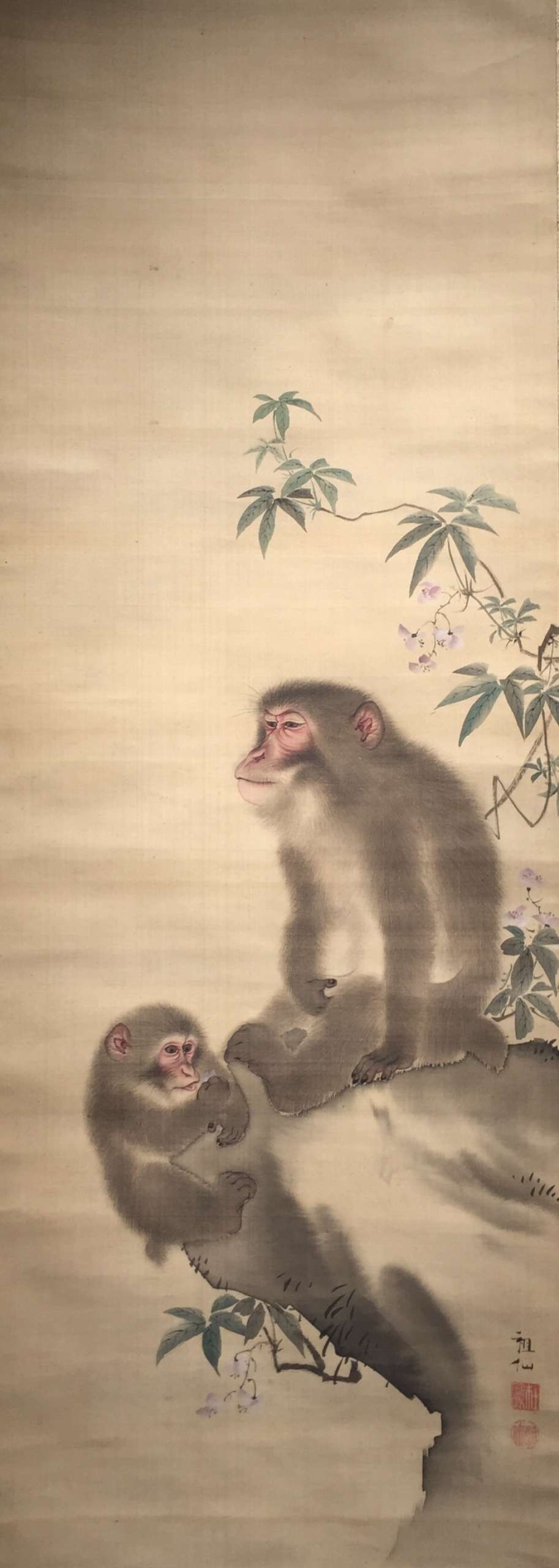 Mori Sosen (1747-1821). A Monkey Seated on a Rock with an Infant Monkey. Hanging scroll painting. Ink and colour on silk. Signed: Sosen. Sealed: Sosen. 108.3 x 38.3 cm. Provenance: According to the box inscriptions, the painting was in the possession of Itakura Katsunao, a daimyo lord in present-day Gunma, in 1808. In 1881, the painting was subsequently acquired by Negishi Shôrei (1833-1897) a master swordsman who established the Negishi school of shuriken ("The only specialist school to have survived is the Negishi-ryū, which was founded by Negishi Shorei in the mid-1800s".)
Mori Sosen (1747-1821). A Monkey Seated on a Rock with an Infant Monkey. Hanging scroll painting. Ink and colour on silk. Signed: Sosen. Sealed: Sosen. 108.3 x 38.3 cm. Provenance: According to the box inscriptions, the painting was in the possession of Itakura Katsunao, a daimyo lord in present-day Gunma, in 1808. In 1881, the painting was subsequently acquired by Negishi Shôrei (1833-1897) a master swordsman who established the Negishi school of shuriken ("The only specialist school to have survived is the Negishi-ryū, which was founded by Negishi Shorei in the mid-1800s".) -
 Woman Looking out a Round Window at a Woman with a Komusō Hat.
Woman Looking out a Round Window at a Woman with a Komusō Hat.Artist Koikawa Harumasa (a.k.a. Banki): fl. 1801–18. Wikipedia: Koikawa Harumasa (恋川 春政; active 1800–1820), later called Banki Harumasa (晩器 春政). Associated with Katsukawa school.
Signed: Banki ga (on the bamboo flower container in the background). Censor's seal: kiwame. Mark of unidentified publisher, Genshoku #1017; Marks U084 Ibiko, p. 387.
References:
Jacob Pins #828.
-
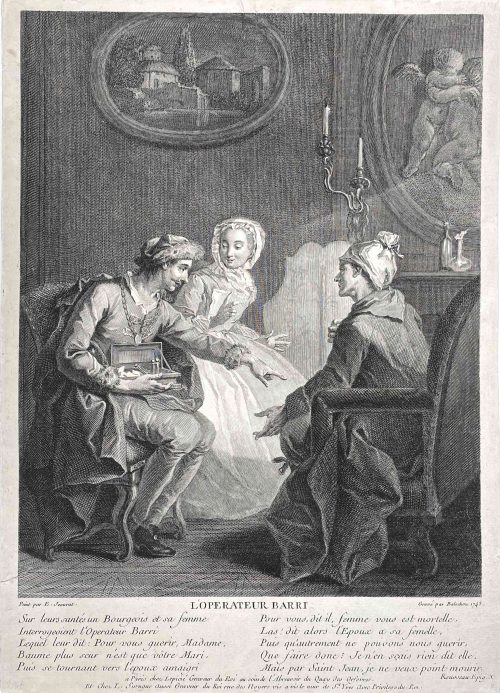
Engraving by J.J. Balechou after E. Jeaurat. A husband and wife ask a quack doctor for advice about health: he suggests substituting himself for the husband in the wife's affections, and she agrees: Épigrammes de Jean-Baptiste Rousseau (French, 1671–1741).
Date: 1743.
Size: 380 x 270 mm
Inscriptions under the image:
Top: Peint par E. Jeaurat | L'Operateur Barri | Grave par Balechou 1743
Middle: Sur leurs santés un Bourgeois et sa femme
Interrogeoient l'Operateur Barri, Lequel leur dit : Pour vous guérir, Madame, Baume plus sûr n'est que votre Mari, Puis se tournant vers l'époux amaigri, Pour vous, dit il, femme vous est mortelle, Las ! dit alors l'Epoux à sa femelle, Puis qu'autrement ne pouvons nous guérir, Que faire donc ? Je n'en sçai rien, dit elle,Mais, par Saint Jean, je ne veux point mourir.
Rousseau Epig. X
Center bottom: a Paris chez Lepicie Graveur du Roi au coin de l'Abreuvoir du Quay des Orfevres. Et Chez L. Surugue Aussi Graveur du Roi rue des Noyers vis a vis le mur de St. Yves Avec Privilege du Roi. -
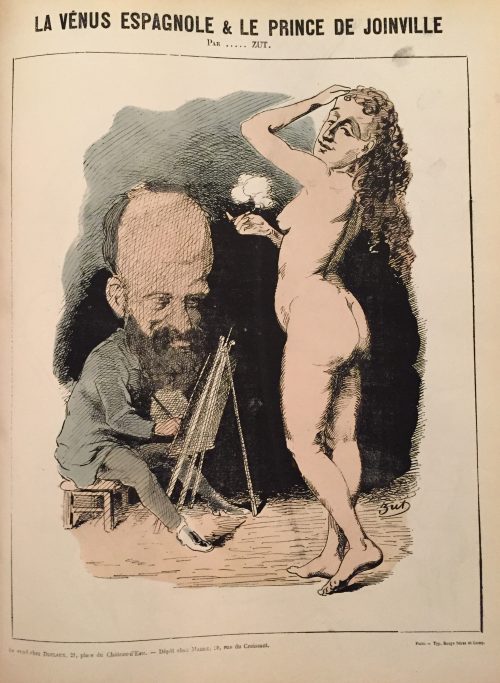 La vénus espagnole et le prince de Joinville par Zut [The Spanish Venus and the Prince of Joinville, by Zut]. Empress Eugénie poses naked for the Prince de Joinville holding a cigarette in her hand. He stares at her intently from his easel.
La vénus espagnole et le prince de Joinville par Zut [The Spanish Venus and the Prince of Joinville, by Zut]. Empress Eugénie poses naked for the Prince de Joinville holding a cigarette in her hand. He stares at her intently from his easel. -
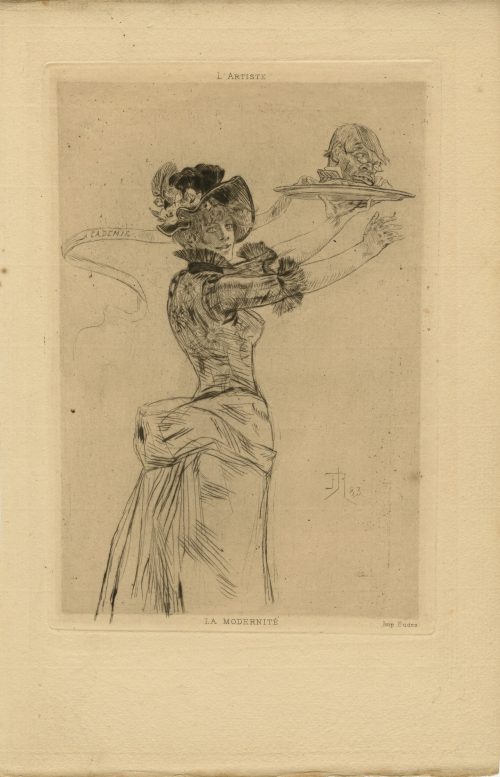
Drypoint on wove paper, depicting a woman in a hat with a ribbon lettered "ACADEMIE", carrying in her hand a male head in spectacles on a plate. Monogrammed "FR 83", inscribed: LA MODERNITÉ. — Imp. Eudes.; in pencil on verso."L'ARTISTE" – OCT. 1886 | (PRUD'HOMME ONTHOOFD) E 332-V". Owner's stamp 'LvM' on verso.
Dimensions: Paper: 27.2 x 17.8 cm; Plate: 19.7 x 14 cm; Image: 18.5 x 13 cm.
Catalogue raisonné: Rouir 767:5; Arthur Hubschmid (1977): 405; Graphics irreverent and erotic (1968): 72.
-
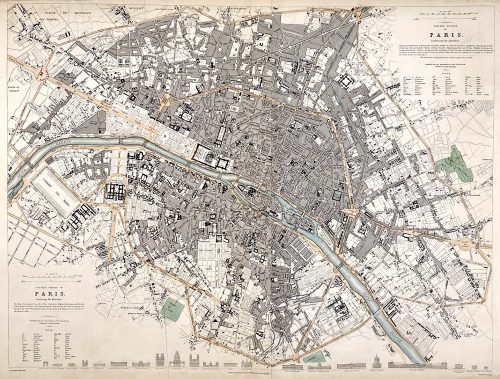 Top right: EASTERN DIVISION OF | PARIS. | Containing the Quartiers | {5 lines in italic} | Published under the Superintendence of the Society for the | Diffusion of Useful Knowledge || Bottom left: WESTERN DIVISION OF | PARIS. | Containing the Quartiers | {4 lines in italic} | Published under the Superintendence of the Society for the | Diffusion of Useful Knowledge || Under the frame: Drawn by W. B. Clarke, Archt. […] London: Published by Chapman and Hall, 186, Strand. April 1st, 1834. [...] Engraved by J. Shury || Dimensions: Sheet: 40.8 x 57 cm; Image: 38.7 x 52.5 cm. Contributors: William Barnard Clarke (British, 1806 – 1865) – artist. John Shury (fl. c. 1814-1844) – engraver. Chapman and Hall (London) – publisher. Society for the Diffusion of Useful Knowledge (SDUK) (British firm, 1826 – 1846).
Top right: EASTERN DIVISION OF | PARIS. | Containing the Quartiers | {5 lines in italic} | Published under the Superintendence of the Society for the | Diffusion of Useful Knowledge || Bottom left: WESTERN DIVISION OF | PARIS. | Containing the Quartiers | {4 lines in italic} | Published under the Superintendence of the Society for the | Diffusion of Useful Knowledge || Under the frame: Drawn by W. B. Clarke, Archt. […] London: Published by Chapman and Hall, 186, Strand. April 1st, 1834. [...] Engraved by J. Shury || Dimensions: Sheet: 40.8 x 57 cm; Image: 38.7 x 52.5 cm. Contributors: William Barnard Clarke (British, 1806 – 1865) – artist. John Shury (fl. c. 1814-1844) – engraver. Chapman and Hall (London) – publisher. Society for the Diffusion of Useful Knowledge (SDUK) (British firm, 1826 – 1846). -
 Utagawa Kunisada [歌川 国貞]; a.k.a. Utagawa Toyokuni III [三代歌川豊国] (Japanese, 1786 – 1865). Signed: Toyokuni ga [豊国 画] in a yellow toshidama cartouche. Publisher: Unknown, seal [久] Kyū (Japanese, fl. c. 1851 – 1861); (Marks 07-023 | U176a, possibly Sagamia Kyūzō). Date seal and double nanushi censor seals: Fuku & Muramatsu, Kaei 6, 2nd month (2/1853). Inscription in a red cartouche: Purple of Edo // Purple of the Bay Capital [江都むらさき] (Edo Murasaki), alluding to Murasaki Shikibu [紫 式部] (Japanese, c. 973/8 – c. 1014/31), the author of Genji Monogatari [源氏物語] (The Tale of Genji), a Heian period novel which was the source of a parody Nise Murasaki Inaka Genji [偐紫田舎源氏] (Fake Murasaki’s Rustic Genji) by Ryutei Tanehiko [柳亭種彦] (Japanese, 1783 – 1842). According to Horst Graebner: The actor is most probably Iwai Kumesaburō III. Iwai Hanshirō VIII [岩井半四郎] (Japanese, 1829 – 1882); other names: Iwai Shijaku II, Iwai Kumesaburō III [岩井粂三郎], Iwai Hisajirō II. One of the series of Kunisada's fan prints in this collection:
Utagawa Kunisada [歌川 国貞]; a.k.a. Utagawa Toyokuni III [三代歌川豊国] (Japanese, 1786 – 1865). Signed: Toyokuni ga [豊国 画] in a yellow toshidama cartouche. Publisher: Unknown, seal [久] Kyū (Japanese, fl. c. 1851 – 1861); (Marks 07-023 | U176a, possibly Sagamia Kyūzō). Date seal and double nanushi censor seals: Fuku & Muramatsu, Kaei 6, 2nd month (2/1853). Inscription in a red cartouche: Purple of Edo // Purple of the Bay Capital [江都むらさき] (Edo Murasaki), alluding to Murasaki Shikibu [紫 式部] (Japanese, c. 973/8 – c. 1014/31), the author of Genji Monogatari [源氏物語] (The Tale of Genji), a Heian period novel which was the source of a parody Nise Murasaki Inaka Genji [偐紫田舎源氏] (Fake Murasaki’s Rustic Genji) by Ryutei Tanehiko [柳亭種彦] (Japanese, 1783 – 1842). According to Horst Graebner: The actor is most probably Iwai Kumesaburō III. Iwai Hanshirō VIII [岩井半四郎] (Japanese, 1829 – 1882); other names: Iwai Shijaku II, Iwai Kumesaburō III [岩井粂三郎], Iwai Hisajirō II. One of the series of Kunisada's fan prints in this collection: -
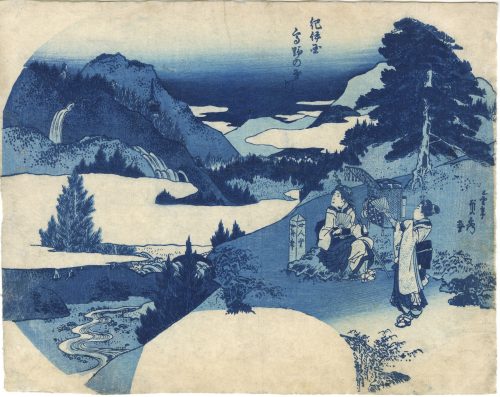 An uncut aizuri fan print showing two travellers admiring the view of the Tama River [多摩川] (Tamagawa) and Mount Kōya [高野山] (Kōyasan) in Kii Province [紀伊国] (Kii no Kuni). Artist: Utagawa Sadahide [歌川貞秀] (Japanese, 1807 – 1879). Signed: Gountei Sadahide ga [五雲亭貞秀画] (Picture by Gountei Sadahide). Publisher: Unknown. Published: c. 1849. No date seal, no censor seal (privately printed?) Media: Fan print [団扇絵] (uchiwa-e), 235 x 300 mm.
An uncut aizuri fan print showing two travellers admiring the view of the Tama River [多摩川] (Tamagawa) and Mount Kōya [高野山] (Kōyasan) in Kii Province [紀伊国] (Kii no Kuni). Artist: Utagawa Sadahide [歌川貞秀] (Japanese, 1807 – 1879). Signed: Gountei Sadahide ga [五雲亭貞秀画] (Picture by Gountei Sadahide). Publisher: Unknown. Published: c. 1849. No date seal, no censor seal (privately printed?) Media: Fan print [団扇絵] (uchiwa-e), 235 x 300 mm. -
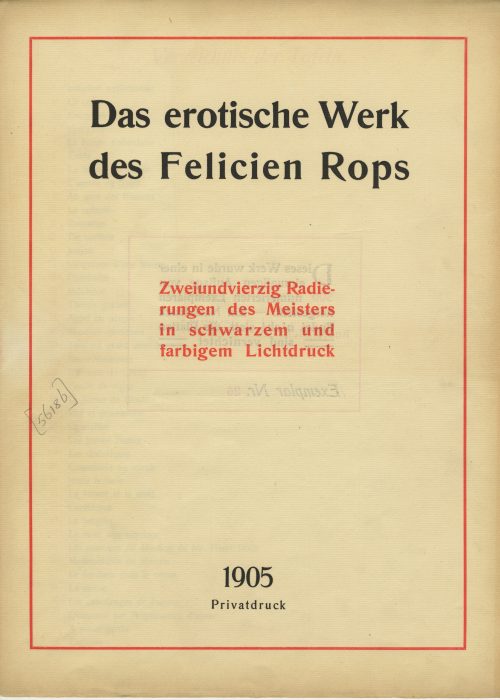
A limited-edition (№26/500) set of 42 etchings and drypoints after Félicien Rops (Belgian, 1833 – 1898), each mounted in a numbered passe-partout, printed posthumously by an anonym in Germany in 1905; in a flapped half faux suede-backed cardboard portfolio with straps, 442 x 335 mm, red embossed lettering to the front cover, bookplate of Richard Teschner (Austrian, 1879 – 1948) pasted inside.
Title-page (in a red frame): Das erotische Werk | des Felicien Rops | Zweiundvierzig Radie- | rungen des Meisters | in schwarzem und | farbigem Lichtdruck | 1905 | Privatdruk ||
Limitation (in a red two-section frame) : Dieses Werk wurde in einer | einmaligen Auflage von | 500 numerierten Exemplaren | hergestellt. — Ein Nachdruck | findet nicht statt, die Platten | == sind vernichtet == | Exemplar Nr. 26 ||
Verzeichnis der Tafeln (Table of Contents): 1. Initiation sentimentale; 2. La croix; 3. Entre-acte; 4. Holocauste; 5. La bonne hollandaise; 6. Étude; 7. La femme au pantin; 8. L’amour de Satan; 9. Au pays des féminies; 10. La volupté; 11. Evocation; 12. De castitate; 13. Joujou; 14. Vengeance d’une femme; 15. Phantasies; 16. Indolence; 17. Théâtre gaillard; 18. Appel au peuple; 19. Masques modernes; 20. Tout est grand chez les rois; 21. Marie-Madeleine; 22. L’amante du Christ; 23. Feuille de vigne; 24. La messe de Guide; 25 Viol et prostitution; 26. Le maillot; 27. Les jeunes France; 28. Les diaboliques; 29. Coquetterie au miroir; 30. Jeune homme; 31. La femme et la mort; 32. Confidence; 33. La bergère; 34. La mère aux satyrions; 35. Les exercices de dévotion de Mr. Henri Roch; 36. Mademoiselle de Maupin; 37. Le bonheur dans le crime; 38. La sirène; 39. Les cabotinages de l’amour; 40. Document sur l’impuissance d’aimer; 41. A cœur perdu; 42. Curieuse.
-
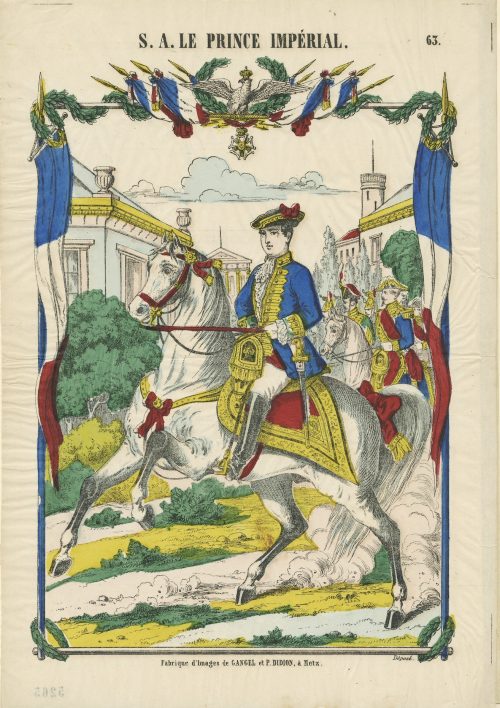 Hand-coloured woodcut on wove paper, 327 x 280 mm; black ink stamp “5265” to reverse, attached to the sheet 470 x 325 mm. Top centre: "S. A. LE PRINCE IMPÉRIAL.", right: "63." Image: equestiral portrait of Prince Impérial. Under the image, centre: "Fabrique d'Images de GANGEL et P. DIDION, à Metz." — "Déposé." Napoléon, Prince Imperial (Napoléon Eugène Louis Jean Joseph Bonaparte] (French, 1856 – 1879). Gangel et P. Didion (Metz); Paulin Didion (French, 1831 – 1879) – publisher/printer.
Hand-coloured woodcut on wove paper, 327 x 280 mm; black ink stamp “5265” to reverse, attached to the sheet 470 x 325 mm. Top centre: "S. A. LE PRINCE IMPÉRIAL.", right: "63." Image: equestiral portrait of Prince Impérial. Under the image, centre: "Fabrique d'Images de GANGEL et P. DIDION, à Metz." — "Déposé." Napoléon, Prince Imperial (Napoléon Eugène Louis Jean Joseph Bonaparte] (French, 1856 – 1879). Gangel et P. Didion (Metz); Paulin Didion (French, 1831 – 1879) – publisher/printer. -
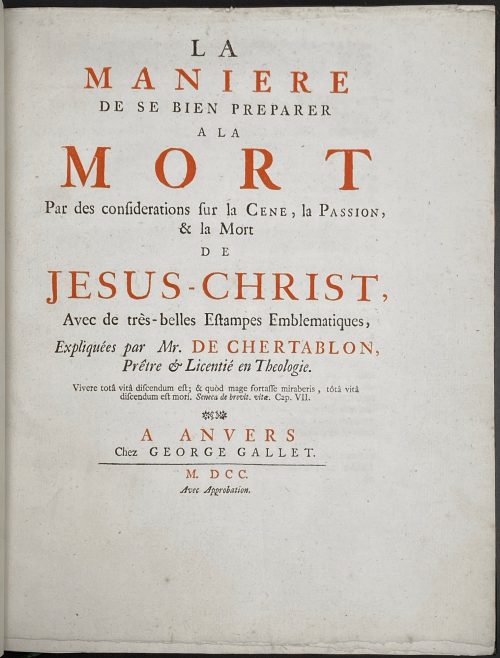 M. de Chertablon. La maniere de se bien preparer a la Mort par des Considerations sur la Cene, la Passion, et la Mort de Jesu-Christ. – Antwerp: George Gallet, 1700. Pagination: ff, [2 - blanks] [2 - t.p., blank] [3 - advert.] 4-63 [64]; 42 copper etched plates by Romeyn de Hooghe: A, B, C, 1-39; [20 - Dutch plate description of the David de la Vigne's Miroir de la bonne mort], bf. Full title: La maniere de se bien preparer a la Mort par des Considerations sur la Cene, la Passion, et la Mort de Jesu-Christ, Avec de très-belles Estampes Emblematiques, Expliquées par Mr. de Chertablon, Piêtre & Licentié en Theologie. Vivere totâ vitâ discendum est; & quòd mage fortasse miraberis, tôtâ vitâ discendum est mori. Seneca de brevit. vitæ. Cap. VII. A Anvers, Chez George Gallet. M DCC, Avec Approbation. / David de La Vigne. Spiegel om wel te sterven, annwyzende met beeltenissen van het lyden onses zaligmaakers Jesu Christi. Verzierd met 42 fyne Geërste Kopere Platen, Door Romain de Hooghe; Te Amsterdam, Voor dezen gedrukt by J. Stigter. Size: 4to, 27.2 x 21.6 cm. Binding: Late 19th century brown calf over marbled boards, spine with gilt lettering, raised bands, double fillet blind panels in compartments; marbled end-papers; bookplate of Samuel Ashton Thompson Yates library, AD 1894. Book illustrated with 42 copperplate etched engravings by Romeyn de Hooghe (Dutch, Amsterdam 1645–1708 Haarlem). According to Bonhams: the plates were "first printed for David de la Vigne's Miroir de la bonne mort. Each of the plates depicts a man contemplating a religious image in order to ease the passing of death, accompanied by commentary and an appropriate verse of scripture for each plate. The present French edition is bound with, as issued, the Dutch translation of David de La Vigne's aforementioned work."
M. de Chertablon. La maniere de se bien preparer a la Mort par des Considerations sur la Cene, la Passion, et la Mort de Jesu-Christ. – Antwerp: George Gallet, 1700. Pagination: ff, [2 - blanks] [2 - t.p., blank] [3 - advert.] 4-63 [64]; 42 copper etched plates by Romeyn de Hooghe: A, B, C, 1-39; [20 - Dutch plate description of the David de la Vigne's Miroir de la bonne mort], bf. Full title: La maniere de se bien preparer a la Mort par des Considerations sur la Cene, la Passion, et la Mort de Jesu-Christ, Avec de très-belles Estampes Emblematiques, Expliquées par Mr. de Chertablon, Piêtre & Licentié en Theologie. Vivere totâ vitâ discendum est; & quòd mage fortasse miraberis, tôtâ vitâ discendum est mori. Seneca de brevit. vitæ. Cap. VII. A Anvers, Chez George Gallet. M DCC, Avec Approbation. / David de La Vigne. Spiegel om wel te sterven, annwyzende met beeltenissen van het lyden onses zaligmaakers Jesu Christi. Verzierd met 42 fyne Geërste Kopere Platen, Door Romain de Hooghe; Te Amsterdam, Voor dezen gedrukt by J. Stigter. Size: 4to, 27.2 x 21.6 cm. Binding: Late 19th century brown calf over marbled boards, spine with gilt lettering, raised bands, double fillet blind panels in compartments; marbled end-papers; bookplate of Samuel Ashton Thompson Yates library, AD 1894. Book illustrated with 42 copperplate etched engravings by Romeyn de Hooghe (Dutch, Amsterdam 1645–1708 Haarlem). According to Bonhams: the plates were "first printed for David de la Vigne's Miroir de la bonne mort. Each of the plates depicts a man contemplating a religious image in order to ease the passing of death, accompanied by commentary and an appropriate verse of scripture for each plate. The present French edition is bound with, as issued, the Dutch translation of David de La Vigne's aforementioned work." -
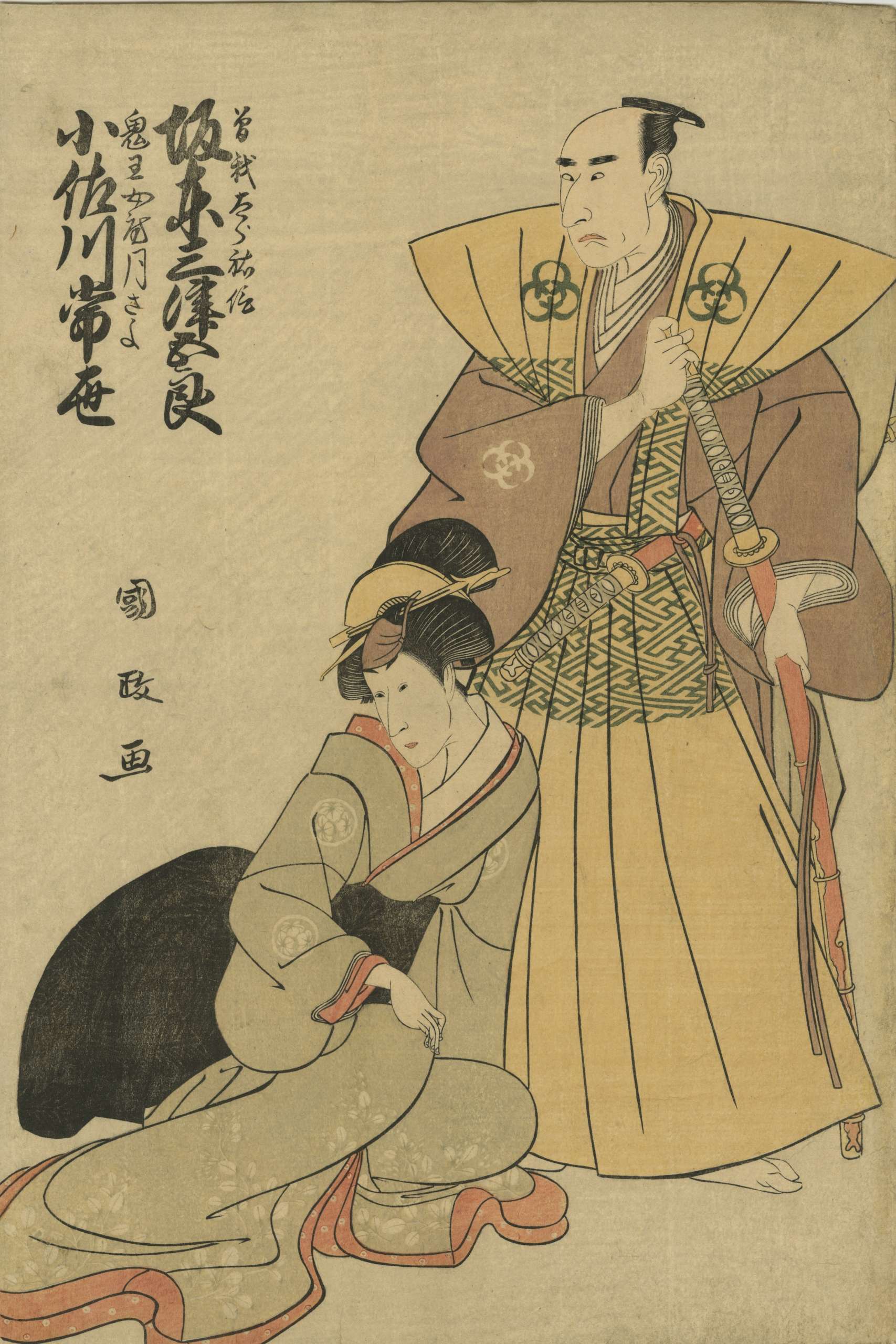 Bando Mitsugoro II as Soga no Taro Sukenobu, the step-father of the Soga brothers, and Osagawa Tsuneyo II as Onio's wife Tsukisayo, in the play 'Omonbi Kuruwa Soga' performed at the Ichimura-za in the 1st month of 1799. Reference: Harvard Art Museums accession number 1933.4.525. Publications: Narazaki Muneshige, Ukiyo-e shuka [Collection of the Masterpieces of Ukiyo-e Prints in Museums] Volume 8: Foggu Bijutsukan [Fogg Art Museum, Harvard University], Neruson Bijutsukan [Nelson Atkins Museum]..., Shogaku-kan (Tokyo, Japan, 1980 [Showa 55]), Color Plate 107; p. 104 (entry p. 191). SOLD
Bando Mitsugoro II as Soga no Taro Sukenobu, the step-father of the Soga brothers, and Osagawa Tsuneyo II as Onio's wife Tsukisayo, in the play 'Omonbi Kuruwa Soga' performed at the Ichimura-za in the 1st month of 1799. Reference: Harvard Art Museums accession number 1933.4.525. Publications: Narazaki Muneshige, Ukiyo-e shuka [Collection of the Masterpieces of Ukiyo-e Prints in Museums] Volume 8: Foggu Bijutsukan [Fogg Art Museum, Harvard University], Neruson Bijutsukan [Nelson Atkins Museum]..., Shogaku-kan (Tokyo, Japan, 1980 [Showa 55]), Color Plate 107; p. 104 (entry p. 191). SOLD -
 An unsigned print, presumably by Katsukawa Shunshō that presumably depicts a kabuki actor Ichikawa Monnosuke II. I was not able to find any reference of the image. Size: Hosoban. According to The actor's image. Print makers of the Katsukawa School. Timothy T. Clark and Osamu Ueda with Donald Jenkins. Naomi Noble Richard, editor The Art Institute of Chicago in association with Princeton University Press, 1994, Ichikawa Monnosuke II was born in 1743, in Ōji Takinogawa, Edo. He died on October 19, 1974. His specialities were young male roles (wakashu) and male leads (tachi yaku). He was considered to be one of the four best young actors of his day.
An unsigned print, presumably by Katsukawa Shunshō that presumably depicts a kabuki actor Ichikawa Monnosuke II. I was not able to find any reference of the image. Size: Hosoban. According to The actor's image. Print makers of the Katsukawa School. Timothy T. Clark and Osamu Ueda with Donald Jenkins. Naomi Noble Richard, editor The Art Institute of Chicago in association with Princeton University Press, 1994, Ichikawa Monnosuke II was born in 1743, in Ōji Takinogawa, Edo. He died on October 19, 1974. His specialities were young male roles (wakashu) and male leads (tachi yaku). He was considered to be one of the four best young actors of his day. -
 Katsukawa Shun'ei. Signed: Shun'ei ga (春英画). Vertical Ōban. No reference whatsoever. Unidentified play, actors, roles, year, theatre. SOLD
Katsukawa Shun'ei. Signed: Shun'ei ga (春英画). Vertical Ōban. No reference whatsoever. Unidentified play, actors, roles, year, theatre. SOLD -
 Artist (attributed, no signature): Suzuki Harunobu [鈴木 春信] (Japanese, c. 1725 – 1770). The title is taken from [LIB-1478.2013] Gian Carlo Calza, Stefania Piotti. Poem of the pillow and other stories. — Phaidon Press, 2010; pp. 148-9. Alternative title: Man sucking woman's breast and a cat sitting under a bonsai tree. The open book beside the couple reads 子春 (Koharu). Woodblock print from the series Mirror Picture of Japan (Wakoku kagami); Size: Horizontal chuban; 21 x 26 cm.
Artist (attributed, no signature): Suzuki Harunobu [鈴木 春信] (Japanese, c. 1725 – 1770). The title is taken from [LIB-1478.2013] Gian Carlo Calza, Stefania Piotti. Poem of the pillow and other stories. — Phaidon Press, 2010; pp. 148-9. Alternative title: Man sucking woman's breast and a cat sitting under a bonsai tree. The open book beside the couple reads 子春 (Koharu). Woodblock print from the series Mirror Picture of Japan (Wakoku kagami); Size: Horizontal chuban; 21 x 26 cm.


